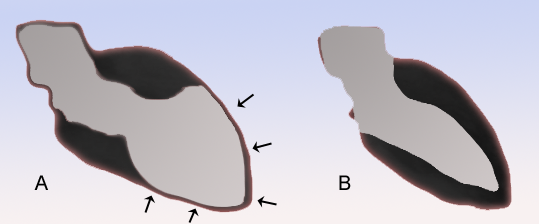Stress cardiomyopathy: Difference between revisions
Hamid Parsa (talk | contribs) |
|||
| (23 intermediate revisions by 5 users not shown) | |||
| Line 15: | Line 15: | ||
}} | }} | ||
{{Stress cardiomyopathy}} | {{Stress cardiomyopathy}} | ||
{{CMG}} | {{CMG}}; {{AE}}{{DN}} {{AKK}} | ||
{{SK}} Takotsubo cardiomyopathy; Tako-tsubo syndrome; | {{SK}} Takotsubo cardiomyopathy; Tako-tsubo syndrome; left ventricular apical ballooning syndrome; LVABS; ampulla-shaped cardiomyopathy; broken heart syndrome; transient apical dysfunction; stress-induced cardiomyopathy; SIC | ||
== [[Stress cardiomyopathy overview|Overview]] == | |||
==[[ Stress cardiomyopathy historical perspective| Historical Perspective]]== | |||
== | == [[Stress cardiomyopathy classification|Classification]] == | ||
== | == [[Stress cardiomyopathy pathophysiology|Pathophysiology]] == | ||
== [[Stress cardiomyopathy causes|Causes]] == | |||
=== | == [[Stress cardiomyopathy differential diagnosis|Differentiating Stress Cardiomyopathy from other Diseases]] == | ||
[[ | == [[Stress cardiomyopathy epidemiology and demographics|Epidemiology and Demographics]] == | ||
==[[Stress cardiomyopathy risk factors | Risk Factors]]== | |||
== [[Stress cardiomyopathy natural history, complications and prognosis|Natural History, Complications and Prognosis]] == | |||
== | == Diagnosis == | ||
[[Stress cardiomyopathy criteria| Diagnostic Criteria]] | | |||
[[Stress cardiomyopathy history and symptoms|History and Symptoms]] | [[Stress cardiomyopathy physical examination|Physical Examination]] | [[Stress cardiomyopathy laboratory findings|Laboratory Findings]] | [[Stress cardiomyopathy electrocardiogram|Electrocardiogram]] | [[Stress cardiomyopathy chest x ray | Chest X Ray]] | [[Stress cardiomyopathy CT| CT]] | [[Stress cardiomyopathy MRI|MRI]] | [[Stress cardiomyopathy echocardiography or ultrasound|Echocardiography]] | [[Stress cardiomyopathy other imaging findings| Other Imaging Findings]] | [[Stress cardiomyopathy other diagnostic studies|Other Diagnostic Studies]] | |||
== Treatment == | |||
[[Stress cardiomyopathy medical therapy|Medical Therapy]] | [[Stress cardiomyopathy surgery|Surgery]] | [[Stress cardiomyopathy primary prevention|Primary Prevention]] | [[Stress cardiomyopathy secondary prevention|Secondary Prevention]] | [[Stress cardiomyopathy cost-effectiveness of therapy|Cost-Effectiveness of Therapy]] | [[Stress cardiomyopathy future or investigational therapies|Future or Investigational Therapies]] | |||
== Case Studies == | |||
: [[Stress cardiomyopathy case study one|Case #1]] | |||
{{WikiDoc Help Menu}} | {{WikiDoc Help Menu}} | ||
{{WikiDoc Sources}} | {{WikiDoc Sources}} | ||
Latest revision as of 16:29, 14 July 2020
| Stress cardiomyopathy | |
 | |
|---|---|
| Schematic representation of Takotsubo cardiomyopathy (A) compared to the situation in a normal person (B). | |
| ICD-9 | 429.83 |
| DiseasesDB | 33976 |
| MeSH | 054549 |
|
Stress cardiomyopathy Microchapters |
|
Diagnosis |
|---|
|
Treatment |
|
Unstable angina/non ST elevation myocardial infarction in Stress (Takotsubo) Cardiomyopathy |
|
Case Studies |
|
Stress cardiomyopathy On the Web |
|
American Roentgen Ray Society Images of Stress cardiomyopathy |
Editor-In-Chief: C. Michael Gibson, M.S., M.D. [1]; Associate Editor(s)-in-Chief: Dima Nimri, M.D. [2] Arzu Kalayci, M.D. [3]
Synonyms and keywords: Takotsubo cardiomyopathy; Tako-tsubo syndrome; left ventricular apical ballooning syndrome; LVABS; ampulla-shaped cardiomyopathy; broken heart syndrome; transient apical dysfunction; stress-induced cardiomyopathy; SIC
Overview
Historical Perspective
Classification
Pathophysiology
Causes
Differentiating Stress Cardiomyopathy from other Diseases
Epidemiology and Demographics
Risk Factors
Natural History, Complications and Prognosis
Diagnosis
Diagnostic Criteria | History and Symptoms | Physical Examination | Laboratory Findings | Electrocardiogram | Chest X Ray | CT | MRI | Echocardiography | Other Imaging Findings | Other Diagnostic Studies
Treatment
Medical Therapy | Surgery | Primary Prevention | Secondary Prevention | Cost-Effectiveness of Therapy | Future or Investigational Therapies